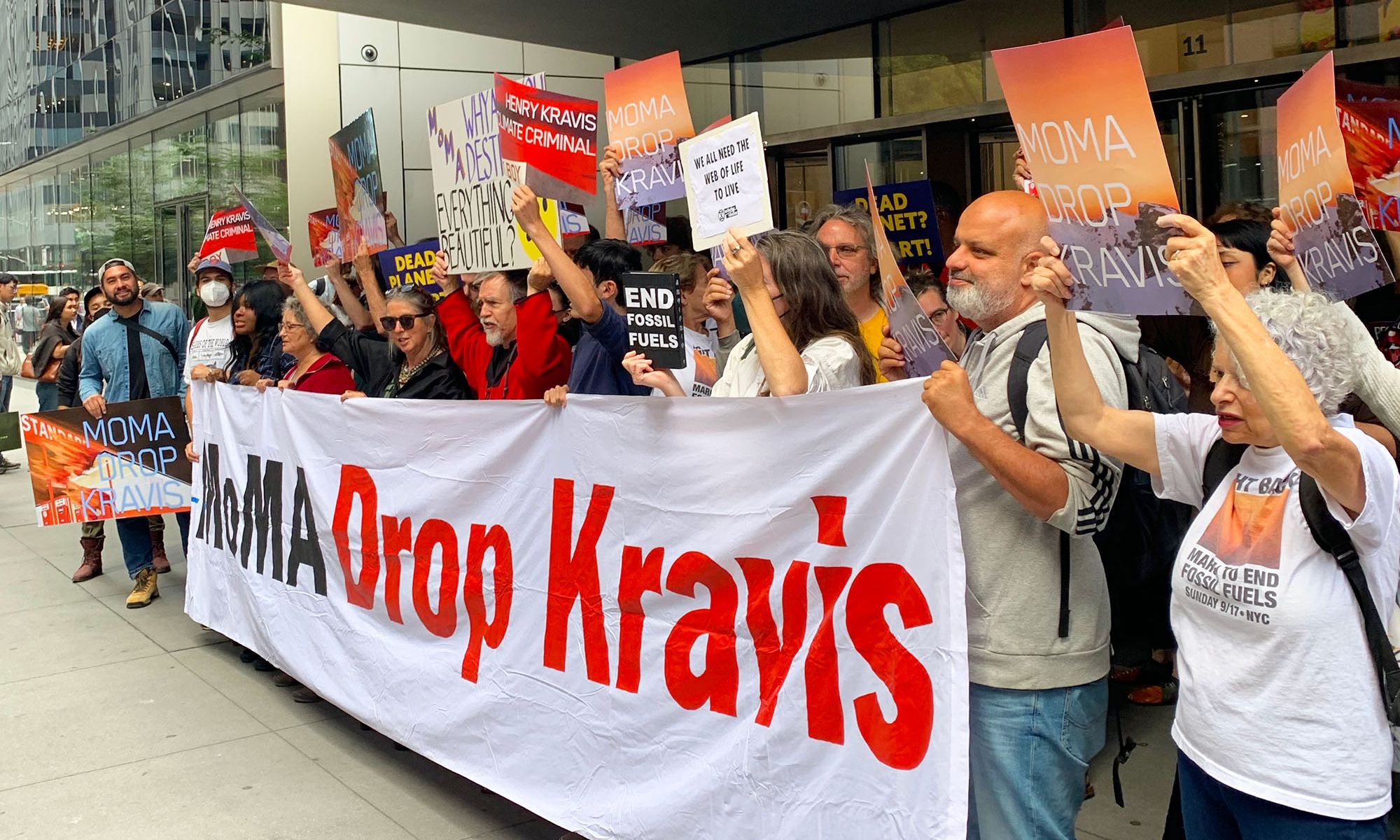Climate protesters outside the Museum of Modern Art's main entrance on 15 September Benjamin Sutton/The Art Newspaper
Around 100 protesters rallied at the main entrance to the Museum of Modern Art (MoMA) in New York on Friday (15 September) and called on the institution to remove its board chair, Marie-Josée Kravis, due to her husband Henry Kravis’s ties to the fossil fuel industry via his private equity firm KKR.
Chanting slogans like “Henry Kravis shame on you, we deserve a future too”, activists from several organisations as well as members of communities feeling the brunt of climate change and fossil fuel extraction—including residents of the Gulf of Mexico coast and hereditary chiefs of Indigenous communities—protested outside the museum’s 53rd Street entrance, handing leaflets to passing office workers and tourists (many of whom then went into the museum).
Many protesters brandished signs featuring the distinctive typefaces and imagery of Ed Ruscha, whose major retrospective just opened at the museum. Several held up a giant banner with the words “MoMA Drop Kravis” rendered in the museum’s signature sans-serif font. Small groups of MoMA security officers and New York Police Department employees looked on; after around an hour the protest peacefully concluded to chants of “we’ll be back!”
Later on Friday, a smaller group of protesters staged an action inside the museum, attempting to occupy it overnight or until MoMA president Glenn D. Lowry agreed to meet with visiting leaders of the Wet’suwet’en Nation in western Canada—where a pipeline project tied to Kravis’s private equity firm will pass through Indigenous lands. In response, the museum closed early. Ultimately, the NYPD arrested 16 activists affiliated with various organisations.
“We’re disrupting business as usual because we demand MoMa be accountable,” Laura Esther Wolfson, a member of Extinction Rebellion, said in a statement following the arrests. “Admit the mistake they’ve made and refuse any association with KKR. Marie-Josée Kravis’s presence on the Board is a hideous stain on one of the world’s most significant cultural institutions.”
Climate protesters outside the Museum of Modern Art's main entrance on 15 September Benjamin Sutton/The Art Newspaper
Henry Kravis is a co-founder, co-chair and co-chief executive of KKR, one of the world’s five largest private equity firms, whose investment portfolio includes companies in the oil and gas sectors in the US, Canada, the UK, Europe and the Middle East. According to a report recently published by the group Private Equity Climate Risks, 78% of the firms’ investments are tied to fossil fuels.
Marie-Josée Kravis has served on MoMA’s board since 1994 and, prior to succeeding Leon Black as chair in 2021, had been board president from 2005 to 2018. The couple’s contributions to the museum have included a 1948 Henri Matisse painting valued at $25m, the Jasper Johns sculpture Painted Bronze (1960) and many other works. A gallery for performance and installation art named after the couple—the Marie-Josée and Henry Kravis Studio—was inaugurated when MoMA’s most recent expansion opened in 2019.
“MoMA is a major cultural institution and as such has a responsibility not to affiliate itself with climate criminals,” says Renata Pumarol of the group Climate Defenders. “No institution should be exempt from the repercussions of supporting the fossil fuel industry.”
Spokespersons for the museum did not respond to requests for comment.
In addition to calling on the museum to remove Marie-Josée Kravis as board chair, activists said the museum should change the name of the Marie-Josée and Henry Kravis Studio and pressure KKR to shift its investments away from fossil fuels.
“A huge amount of funding is still going to fossil fuels and a lot of it is coming from private equity,” says Michael Kink, the executive director of the Strong Economy for All Coalition. “KKR and Kravis could be climate heroes funding clean energy projects, but instead they have been caught buying when everyone else is selling.”
Climate protesters outside the Museum of Modern Art's main entrance on 15 September Benjamin Sutton/The Art Newspaper
The protest’s timing dovetailed with several poignant events, including the first day of member previews for Emerging Ecologies Architecture and the Rise of Environmentalism, a new MoMA exhibition about green architecture. It also comes amid a string of protests in New York City leading up to the launch on 17 September of Climate Week (until 24 September), a series of events and demonstrations around the city timed to coincide with the 78th session of the United Nations General Assembly (19-26 September), where sustainability, climate change and climate justice figure prominently on the agenda.
“If MoMA was being honest, it would create a truth and reconciliation committee to examine its history of taking money from the fossil fuel industry,” Kink adds. “Instead, the museum is continuing its destructive tradition of laundering the reputations of fossil fuel companies.”
The museum, since its founding, has been connected to and supported by the Rockefeller family, whose fortune largely derives from the company Standard Oil. To this day, its board of trustees includes both Sharon Percy Rockefeller and lifetime trustee David Rockefeller, Jr. Presumably by pure coincidence, on Friday the Rockefeller Foundation announced it will make a $1bn investment in climate-related programmes over the next five years.
A similar climate protest in June, timed to disrupt the museum’s annual Party in the Garden fundraising gala, happened to coincide with thick smoke from record wildfires in Canada blanketing New York City.

